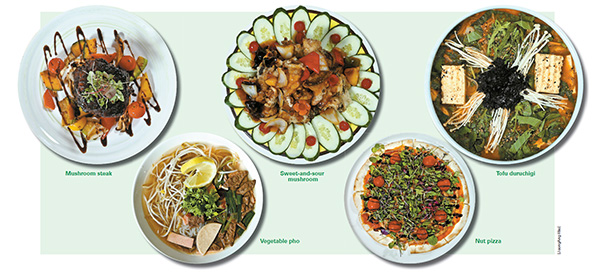Vegetarian dishes require rethinking, creativity

What do you get when you combine the recent fads in Korea of “well-being” (or healthy lifestyles) and “healing?” A heightened interest in vegetarian diets.
People seeking a healthy mind and body might have given it a thought: “Should I try this?” But for most people in Korea, giving up meat is a formidable challenge. Can people continue to feel the joy and pleasure of food without meat? The JoongAng Ilbo visited five major vegetarian restaurants in Seoul to find out their recipe secrets and get some pointers.
Mushroom steak
Solhyanggi in Gye-dong
For newbie vegetarians who miss the taste of meat, this mushroom steak could provide some satisfaction. This restaurant grills a veggie patty using soy protein and shiitake mushrooms.
“People who have just become vegetarian often seek this dish, just like those who just quit smoking turn to e-cigarettes,” says Lee Do-gyeong, CEO of the restaurant and self-proclaimed researcher of vegetarian menus.
Soy protein is made from protein extracted from beans with a chewy texture similar to that of meat. It is available at retailers that sell vegetarian food products, like Vegeland, Yogi Hut and Loving Hut.
In order to make the dish, mix soy protein, boiled mushroom and vegetables in a blender. Then, make a patty using gluten flour, glutinous rice flour, salt and pepper. Afterward, grill it for about 20 minutes at 180 to 200 degrees Celsius.
Vegetable broth pho
Loving Hut Thien Dang in Sadang-dong
One of the biggest obstacles to maintaining a vegetarian diet in Korea is meat broth. Meat broth - which often uses anchovies - is a key ingredient in doenjang soup (bean paste soup), steamed sesame leaves and kimchi noodles, which all seem quite meat-free on the surface.
This is also the case with pho, the Vietnamese noodle soup, which is quite popular in Korea.
But this restaurant does what it can. It uses vegetable, rather than meat, broth. The cook adds shiitake mushrooms, white radish, cabbage, onion, carrot and kelp to water and cooks it at a low boil for two to three hours.
But the most glaring weakness of vegetable broth is a lack of softness compared to meat broth.
This restaurant sought to overcome the problem through the use of green onions and sunflower seed oil. After frying the white parts of green onions in the oil, they add it to the broth.
Sweet and sour mushroom
Garobee in Yeoksam-dong
Sweet and sour pork (ttangsuyuk in Korean) is often the most popular dish in Korean-Chinese restaurants. This restaurant attempts to offer a vegetarian dish close to the sweet-and-sour-pork, but uses mushrooms instead of pork. Because they are chewy like meat, mushrooms are frequently used in vegetarian dishes.
The cook uses sunflower seed oil - instead of egg - when making the batter. Another secret is that this restaurant does not use flour, which makes the fried food softer and tastier. However, the lack of flour makes it hard to keep leftovers because the mushrooms tend to stick together.
As with the sweet-and-sour pork, the sauce is the most important component. The cook uses soy sauce, vinegar, sugar and water, and adds white radish, green onion, onion, pepper, chili, cinnamon and garlic, then boils the sauce for 30 minutes. Then they add a lemon and let it sit for a day. The cook puts in starch, brings to a low boil and then adds vegetables.
Tofu duruchigi
Chorokddeul in Hwigyeong-dong
Duruchigi is a traditional Korean mixed dish of either pork or beef and several vegetables and seasonings - some say it’s something between a stew and casserole.
This restaurant, however, makes tofu duruchigi, a mixed dish of tofu and noodles. The key here is the noodles. They are unique noodles made of whole-wheat flour, acorn jelly powder and a batter of brown rice, oatmeal, soybeans and linseed. Because of these unique noodles, the dish has a deep and rich taste that Koreans love. It makes them crave a bowl of rice.
Kim Bok-hoe, CEO of the restaurant, says that in order for dishes that are meat-free to have a deep and rich taste, each ingredient should have a strong and distinct flavor. It is because there is no meat to cover up the bland and dull flavors.
Kim said the restaurant uses only tofu that is unique the Gangneung region.
Nut pizza
Tomaster in Seogyo-dong
Can you imagine pizza without any cheese?
The nut pizza served in this restaurant comes without cheese, but it looks and tastes similar to regular pizzas. The nut sauce - made of walnuts, almonds, peanuts and cashews that are ground together with soy bean milk - bears much resemblance to cheese in terms taste and nutrition with protein and fat.
The cook uses olive oil instead of egg when making pizza dough, which allows him to make it as thin as possible. Eliminating eggs from the recipe reduces the amount of flour needed, which means the dough is stickier in texture. The nut pizza here is less than 3 millimeters thick.
This way, calories can be reduced without compromising taste.
The restaurant suggests that if you find it too much work to make dough, you can thinly slice potatoes and put the toppings on them.
By Lee Ji-young, Kim Hyung-eun [hkim@joongang.co.kr]










with the Korea JoongAng Daily
To write comments, please log in to one of the accounts.
Standards Board Policy (0/250자)